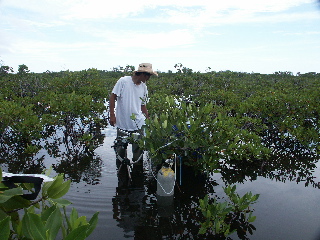Did we miss a treatment?
Are we studying, or killing, Twin Cays?
Based on the results of Candy Feller’s dissertation research, the current round of fertilization treatments includes controls, N and P fertilized trees. But what happened to the N+P treatment? Are we missing an interaction?
Results of a one-off fertilization experiment at Batfish suggest that the answer may be yes. Indeed, with respect to growth and leaf production, P and NP effects were similar. Preliminary surveys 7 months after fertilizer application indicate that control and N trees have added the same number of leaves without increases in internode growth, and that NP and P trees are also equal, and hugely more productive. But for photosynthesis the rates were similar on controls, N and P fertilized trees, and elevated only with the NP combination.
 |
Graduate student Hiro Takemasa from Illinois monitors photosynthesis analyzer at Batfish pond in October. |
But don’t look too closely. Batfish was chosen for our experiment because it was largely untouched and had some interesting dwarf trees. It is also a good place to get equipment in and out… a simple 3 minute walk without climbing over anything. But in the short, two weeks, that two of us worked there this last month, the damage to the peat was readily noticeable. Roots appeared on the surface that had previously been buried, and the surface became noticeably softer underfoot.
Obviously, our goal is to learn as much about this system as possible in the short 5 years we have. And we could argue that the damage we might do will be far less extensive and long lived than the damage that is occurring by clear cutting on both islands, and the possible resort development that might come at Zabame's place on the east side (he reportedly also owns Maya Island Air, Blue Marlin and other resorts).
Still, a word of warning to us all. Twin Cays is not accessible without cost, and like most things ecosystems we visit, the cost is not one we will pay. Tread softly and seldom.